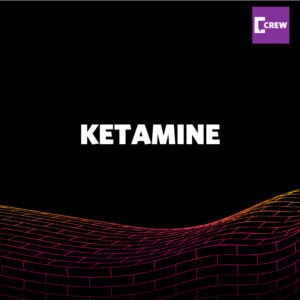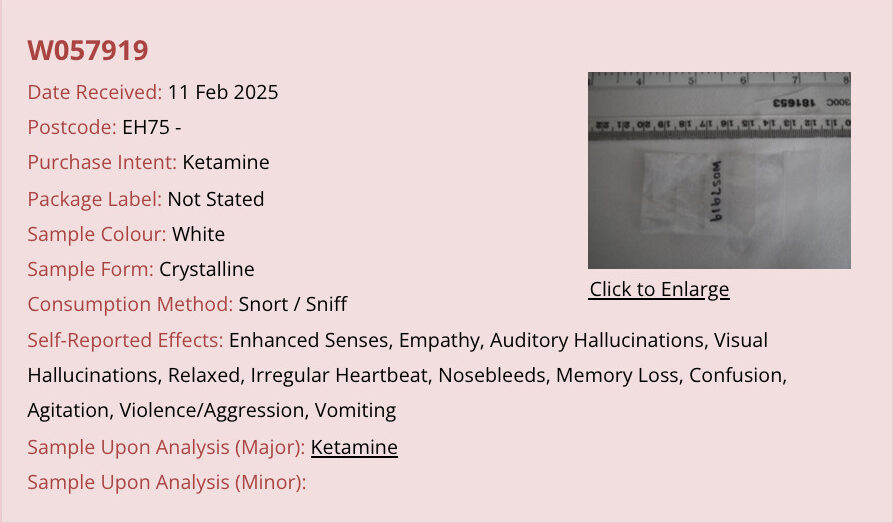Ketamine
Pronounced: ket-ah-meen
Reading time: 5 minutes
In this post…
What you need to know
- Ketamine is a dissociative drug and is a non-opioid sedative, sometimes referred to as ket, K, special K or ‘horse tranquilliser’, and is currently under review by the Advisory Council on the Misuse of Drugs as of January 2025.
- The effects include sedation, memory loss, feeling floaty or ‘out-of-body’, reduced ability to feel pain and numbness, loss of coordination and at higher doses being unable to move.
- Ketamine may slow down heartrate and breathing, so it can be potentially life threatening if mixed with other ‘downer’ type drugs, such as alcohol, opioids, benzodiazepines (Valium, Xanax, etizolam), and GHB.
- Ketamine and alcohol is a risky combination as both can affect your coordination, balance and perception of pain so if you feel unwell, stay with someone and seek help. If you can’t avoid alcohol completely, try to limit yourself to only a few drinks, choose drinks with a lower alcohol content and drink water or soft drinks between alcoholic ones.
- Mixing ketamine with cocaine can increase the risk to your heart. Cocaine can dull the effects of ketamine, which could cause you take more of each drug to get the desired effect. This won’t improve your experience but will increase the risk to your health.
Recent Drug Checking Results
Ketamine is most often represented as itself in WEDINOS drug testing results, ie people have bought with the intention to purchase ketamine. These results are based on the samples that are being submitted, from across the UK, and are not conclusive proof of trends in ketamine. For example, 1 area may be submitting multiple samples or samples from the same batch.
Of the 116 samples submitted where the purchase intent was ketamine: 97% were confirmed as ketamine. Most often it may be sold as ketamine but unless tested, content and purity cannot be assessed by appearance. Purity can vary even within batches, so it is important to take test doses and start low; go slow.
- 2% of samples where the sender intended to purchase Ketamine in the last 6 months have contained adulterants and 1% did not contain any active compound.
- 32 samples submitted, in the last 6 months (October 2024 – February 2025), where the sender intended to purchase another drug have contained ketamine.
Of these samples:
- 22% benzodiazepines (7 samples) where ketamine was present alongside another benzodiazepine rather than the intended purchase.
- 19% MDMA (6 samples) where ketamine was present instead of the intended purchase.
Ketamine has been found in samples (appearing white or clear rod shaped crystalline powders), missold as MDMA, cocaine, 2CB and benzodiazepines. People who have taken ketamine unintentionally report: feeling generally unwell, nausea or vomiting, and have reported feeling anxious afterwards.
Harm reduction
- Test your drugs – this allows you to be more aware of unexpected contents. Visit www.crew.scot/how-do-i-test-my-drugs for more information on how you can test your drugs.
- Start low; go slow. Begin with a test dose first.
- Plan your doses in advance – your perception of a dose once you are already high will not be accurate.
- Ketamine can also affect your perception of time – use a watch or timer to keep track of how frequently you are dosing leaving a minimum of 2 hours before each dose.
- Try to avoid mixing drugs, as this may increase your risk of experiencing an overdose.
- If possible, try not to take your drugs alone, and don’t let your mates take them alone either. Stay with a group of people you trust and look out for each other, staying aware of the signs of an overdose.
- Think about your setting – ketamine can affect your balance and coordination — take it in a space which avoids dangers such as glass (including tables and doors), water (including rivers and lakes), heat (including cookers, open fires and radiators) and traffic. Be aware that as ketamine reduces your ability to feel pain, you may not realise how bad injuries are until the effects wear off.
- Ketamine can make you feel sick — ensure anyone who has been taking ketamine and is sleeping (or is unable to move) is placed on their side to prevent choking in case they vomit.
- Grind or crush ketamine down as fine as possible before use. This makes it easier to judge a dose, speeds up absorption into the body and reduces the damage to soft tissue from abrasion.
- Avoid using bank notes as a tool to snort drugs, as they aren’t disposable and can cut the inside of your nose — post-its or paper straws are a good alternative to notes.
- Sharing tools can spread infections and blood borne viruses (e.g. hepatitis C, HIV) – only use your own equipment. Get tested regularly for BBVs.
- Ketamine can seriously and permanently damage your bladder. Symptoms of urinary tract/ bladder damage include cramps, abdominal pain, difficulty urinating, frequently urinating, jelly-like or blood in urine (pee). If you experience these symptoms, we recommend trying to reduce or stop ketamine use and seek medical help. Any route of administration can lead to this pain and damage.
In an emergency
- The signs of an overdose might include:
- Difficulty breathing / snoring / raspy breathing,
- Blue hands, lips or nailbeds,
- Pale, cold and clammy skin,
- Pinpoint pupils,
- Unconsciousness or unresponsiveness.
- Always call 999 in an emergency.
- Always let medical professionals know if you have a history of ketamine use if they are going to be administering anesthetic or pain numbing drugs as ketamine tolerance can have an impact on how effective these are.
- If you are unsure if the person has taken opioids, always use naloxone as this will not cause any harm and could save their life.
- If you have any health conditions that require timely medication e.g. diabetes, then take extra care to set reminders – see our drugs and diabetes guide for more info.
References
Recent updates
The ACMD was commissioned in January 2025 to assess the harm associated with ketamine based on data in the UK estimating that there had been an increase in young people (16-24 years old) taking ketamine over an 11 year period. The commissioning letter is linked here.
Any updates on this will be available and we are continuing to offer our harm reduction information and training on ketamine, and other drugs, to anyone working with young people in services.








